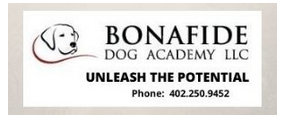- Do you subscribe to Dharma Dog Training’s Newsletter? You should.
- A Unique Campaign from The Humane Society of the United States
- Rabid bats in Omaha- Stay safe, prepared with these tips
- Springtime Activities in Omaha
- Mill Dog Monthly from Bailing Out Benji
- World Spay Day, Legislative Alert in Nebraska
- Attend the Nebraska Rescue Council’s monthly meeting this Saturday
- Five Hard-to-Ignore Reasons to Adopt!
- Paws in Pink to Benefit Breast Cancer Foundation
- VCA, Inc. Acquires MidWest Vet Specialists from Kansas State University
Understanding the Differences Between Wet and Dry Dog Food

Dry dog food has been around for a while (since the late 19th century actually). Canned dog food came along a bit later (in the early 20th century). While both types of food have remained popular since their introduction, many dog owners are curious as to what the specific nutritional differences are between the two food types.
There’s a multitude of differences between wet and dry dog food, most of which can have both positive and negative effects on your dog’s health. Deciding which type of dog food to feed your pup can be a bit more involved than it sounds, which is exactly why we’ve outlined the primary differences between these two dog food types in the below sections.
Wet dog food has been getting a lot of flack lately for numerous reasons, however, one of the primary ones is the fact that it directly leads to increased levels of BPA (in both dogs and humans).
What is BPA? BPA is a type of chemical that causes changes to the body’s endocrine system as well as its gut system. Dry dog food simply doesn’t suffer from this problem (which is a major plus to its other benefits).
Dry Dog Food: Popular Since the 1800s
The first dry dog food product was introduced to the public in England, all the way back in the 1850s (as a “dog cake”). Fast forward to 2020, and dry dog food is just as popular as it must have been back then (although the ingredients have certainly improved).
There are many reasons why using a high-quality dry dog food (such as Nature’s Variety dry dog food recipe) can be beneficial for your pet. While different brands use different ingredients (which all vary in quality depending on the specific brand/recipe), the pet food industry is a government-regulated industry that needs to conform to predefined standards (which guarantees a certain level of nutritional value).
What about a raw diet? Could it be that raw is the best thing to feed an old dog?
Some of the main benefits that come with using dry dog food include:
- Decreased severity and/or presence of plaque on your dog’s teeth.
- A lower level of gum diseases/gum-related health issues.
- Much more difficult to become spoiled (compared to wet food).
- Significantly less expensive than canned/wet dog food.
- Not as prone to bacterial exposure.
What to Look for When Choosing a Dry Dog Food Brand
There are many benefits to dogs eating a dry food diet, but how do you determine which product to purchase? Which brand should you buy? Are there certain ingredients to avoid? What about macronutrients? Blackhawk Pet Care can provide even more additional info.
These are all excellent questions, and if you’re serious about your dog’s diet then they are necessary questions to be asking. Generally speaking, the primary ingredient of any high-quality dog food is going to be protein (ideally animal-based). So, that’s the first thing to look out for. Some of the top brands/recipes contain a single source of animal-based protein as their primary ingredient (e.g. duck, chicken, cow, etc.).
The second thing that you need to look for is the carbohydrate content. While protein is important in a dog’s diet, carbohydrates are equally as important (especially when it comes to giving your dog the energy that it requires throughout the day). Keep in mind, though, that many dogs have allergies (or sensitivities) to certain types of carbs (e.g. wheat).
One very important aspect of dry food that needs to be considered is the fact that nearly all of them use some type of preservative (in order to stay fresh). This is particularly a problem with “cheap” dog food brands (which are notorious for using large amounts of artificial ingredients and preservatives). This is one more reason to only go with a reputable brand that only uses high-quality ingredients (and minimal preservatives).
Canned vs Dry: Closing Thoughts
The debate between canned dog food and its dry alternative has been raging for quite a while (ever since canned dog food came onto the scene in the 1920s). Thanks to research developments in the veterinary science field (particularly in regards to nutrition), we now understand that dry dog food is usually the optimal choice for most dogs. Of course, this all depends on your dog’s medical history, breed, age, etc.
Dry dog food has numerous benefits, especially when compared with wet food. However, in order to provide your dog with the highest level of nutrition possible, you need to purchase your food from a high-quality brand that uses nutrient-dense ingredients.
Latest News
-
Join Us at Pick A Pooch 2025: A Fun-Filled Weekend for the Whole Family
A Fun-Filled Weekend for Pet Lovers and Families Alike Mark...
- Posted 1 year ago
- 0
-
Beardmore Presenting Sponsor At This Years Pick-A-Pooch event
🐾 We are thrilled to announce that Beardmore Subaru is...
- Posted 1 month ago
- 0
-
How Having A Pet Can Change Your Life
Having a pet can open your heart in ways that...
- Posted 3 months ago
- 0
-
How To Improve The Life Of Your Senior Pet
Do you have an elderly fur baby and want to...
- Posted 3 months ago
- 0
-
Springtime Activities To Enjoy With Your Furry Friends
Are you preparing for warmer weather and want some ideas...
- Posted 4 months ago
- 0
-
Pros And Cons Of Microchipping Your Pets
Have you considered whether your pets should be microchipped and...
- Posted 5 months ago
- 0
-
The Best New Fun Toys For Dogs And Cats
The Best New Fun Toys For Dogs And Cats Did...
- Posted 5 months ago
- 0
-
Heartfelt Ways To Show Your Pet You Love Them
Did you know there are more ways to show your...
- Posted 6 months ago
- 0



















You must be logged in to post a comment Login